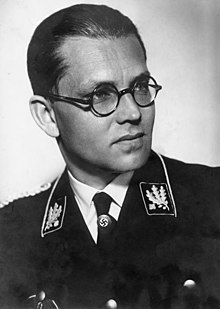Philipp Bouhler | |
|---|---|
 Bouhler as an SS-Obergruppenführer in 1936 | |
| Reichsleiter | |
| In office 2 June 1933 – 23 April 1945 | |
| Chief of the Chancellery of the Führer of the NSDAP | |
| In office 17 November 1934 – 23 April 1945 | |
| Chief of NSDAP Censorship in the Reichsleitung | |
| In office October 1936 – 23 April 1945 | |
| Chief of Action T4 | |
| In office 1939–1941 | |
| Nazi Party National Business Manager | |
| In office 27 March 1925 – 17 November 1934 | |
| Personal details | |
| Born | 11 September 1899 Munich, Bavaria, German Empire |
| Died | 19 May 1945 (aged 45) Altaussee, Styria, Allied-occupied Austria |
| Cause of death | Suicide |
| Political party | Nazi Party (NSDAP) |
| Other political affiliations | Greater German People's Community |
| Spouse |
Helene Majer
(m. 1934; died 1945) |
| Education | Philosophy |
| Military service | |
| Allegiance | German Empire |
| Branch/service | Imperial German Army |
| Years of service | 1912–1917 |
| Rank | Leutnant |
| Unit | 1st Royal Bavarian Foot Artillery Regiment |
| Battles/wars | |
| Awards | Iron Cross, 2nd class |
Philipp Bouhler (11 September 1899 – 19 May 1945) was a German senior Nazi Party functionary who was both a Reichsleiter (National Leader) and Chief of the Chancellery of the Führer of the NSDAP. He was also the SS official responsible for the Aktion T4 euthanasia program that killed more than 250,000 disabled adults and children in Nazi Germany, as well as co-initiator of Aktion 14f13, also called Sonderbehandlung ('special treatment'), that killed 15,000–20,000 concentration camp prisoners.
Bouhler was arrested on 10 May 1945 by American troops. He committed suicide on 19 May 1945, while in the U.S. internment camp at Zell am See in Austria.[1]
- ^ Miller 2006, p. 155.